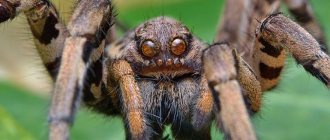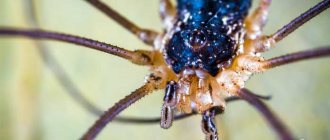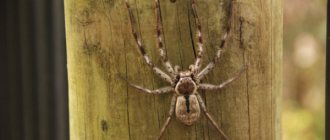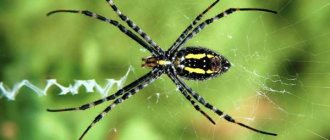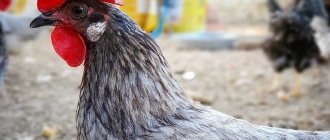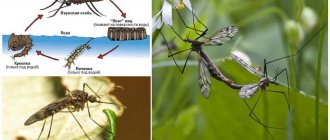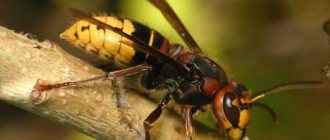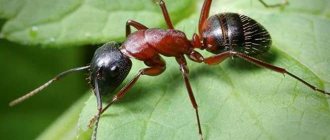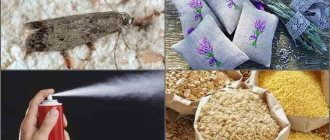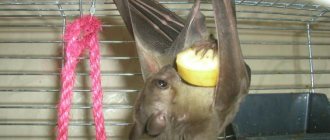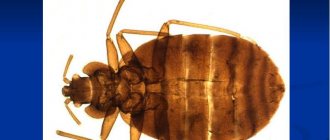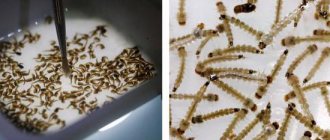I warn you! If you suffer from arachnophobia, you might want to avoid this list. After reading this article, you may realize that these creatures are more diverse and fascinating than they seem at first glance. The world of spiders will never cease to amaze us! They are one of the most widespread predators in the world, adapted to almost all existing habitats. Of course, this led to the emergence of a huge number of species, many of which are still not studied by science. Here are a dozen of the most unusual spiders from around the world.
1
Whip spider / Argyrodes colubrinus
Found in Australia, this species has a long, thin abdomen resembling the body of a snake, which is why its species is called colubrinus, meaning "serpentine." Such an amazing appearance, again, an example of camouflage. This appearance gives it the appearance of a small twig, which is how it avoids the attention of predators. The whiplash belongs to the same family as the dangerous black widow. The basis of its diet consists of small spiders and insects.
By the way, on our website topcafe.su there is an interesting article about the amazing spiders of Australia.
3
Wax seal
Cyclocosmia cannot be considered one of the most beautiful representatives of arachnids, but it has one amazing body part that sets it apart from the rest of the family. What makes it unique is the large chitinous growth at the back of the body, which resembles a round shield, wax seal or bottle cap.
On this appendage there is a large pattern made so symmetrically and neatly that it is even difficult to believe that this is the work of nature and not man. The drawing is very specific and resembles the symbolism used by sects or various cults.
In fact, this plug has a protective function. Cyclocosmius likes to wait out danger in a hole, which he quickly pulls out if it seems to him that something is threatening his life and peace. It places its body in the hole head first, and the entrance is securely sealed with a chitinous plug facing the enemy. In this way, he manages to avoid most of the dangers that await the small creature at every step.
Spiders are creatures that many women, and often men, are afraid of. The film industry tirelessly exploits their predatory and dangerous image for horror films. However, it is important to remember that they have accompanied humans since the very beginning of mankind, and most of them live in our homes and help us get rid of flies, mosquitoes and other annoying insects in the most environmentally friendly way available. Therefore, you should not treat them so hostilely, but rather pay attention to the amazing properties of these little neighbors of ours.
Silver spider / Argyroneta aquatica
Better known as the Water Spider or Diving Spider. It lives in ponds, slow-flowing rivers and shallow lakes. The Water Spider creates an underwater shelter with silk and fills it with air that it brings from the surface. It traps air bubbles in the hair that covers its body and paws. Once filled with air, the silk shelter takes on the shape of a bell and becomes silvery, hence the name (Argyroneta means “silver net”).
Argyroneta aquatica spends most of its time inside the bell; it only needs to replenish the air from time to time. It feeds on any aquatic invertebrates and various larvae; they also prey on small fish and tadpoles.
4
Spider with scorpion tail
The spider is so named because of the female's unusual abdomen, which ends in a scorpion-like "tail." When the spider feels threatened, it twists its tail into an arch, which resembles a scorpion. Only females have such a tail; males look like ordinary spiders, but they are much smaller in size.
These creatures live in Australia and are completely harmless. They often live in colonies, although each female spider builds her own webs and does not risk claiming the territories of other females.
Ant jumping spider / Myrmarachne platanoides
One of the most unusual spiders in appearance. Take a look at another case of deception among arthropods. This is a jumping spider that looks like a weaver ant. It is known for its painful bite and for the fact that it produces two different chemicals that increase the pain in the bite wound. Many birds, reptiles, and amphibians avoid encounters with these pseudoants.
Myrmarachne plataleoides is found only in India, China and Southeast Asia, but is not the only species that mimics the ant species. There are many other species found in the tropics that mimic many different types of insects.
Do you know why insects are so important? If not, then be sure to read our article on TopCafe.
5
Champions
Jumping spiders do not amaze with their size, because they barely reach 0.5 cm, but this does not stop them from being amazing. Living in Thailand, these spiders have the same bright colors as the rest of the nature of this country: their bodies shimmer from purple to golden.
Jumping spiders got their name for a reason: these small creatures can jump over a distance of up to 50 cm. If we compare their size with a human, then with such abilities a person could jump from a standstill to a distance of 200 meters!
In order to make such leaps, these creatures resort to the help of hydraulics, probably without even knowing what it is: they pump blood into all their legs, creating excess pressure, and during the jump, a second outflow creates additional buoyant force.
These arachnids use their amazing skill while hunting, quickly overtaking the smallest midges and jumping towards them. In addition, they are able to move along any steep walls and glass, because their miniature paws are equipped with special hairs and microscopic claws that perfectly adhere to even the smoothest surface.
Smiling spider / Happy face spider
The amazing lines on his yellow belly sometimes take the shape of a smiling face. However, this trait does not exist in all individuals of this species. Some "lucky spiders" may have markings on their faces that resemble different facial emotions. Unfortunately, this cutie is considered critically endangered due to its limited range and the decline of its natural habitat.
Nephila the goldweaver
This spider lives in warm countries: Africa, Australia, Asia, etc. It has one amazing feature: the web that the nephila goldweaver uses to build its networks is so strong and durable that not only large insects, but also medium-sized birds become entangled in it. It is these networks that are an excellent limiter on the growth of the number of large pests that do not have other natural enemies in their distribution area.
Only females of this species can weave such a strong network. It becomes especially thick during the mating season and the appearance of small spiders. The males crowd at the very edge of the web, since they cannot build decent housing for themselves.
The strong thread that the gold weaver weaves has been adopted by people. In Cambodia, beautiful napkins, scarves, shawls, etc. are knitted from this material. Fishermen in the Pacific and Indian Oceans use spider webs to make beautiful traps for catching fish, and in New Caledonia, local delicacies are prepared from nephilus goldworms.
Kipling's Bagheera / Bagheera kiplingi
Not all spiders are dangerous predators; among them there are quite harmless herbivores. The name of this little Bagheera Kipling was given in honor of the character from The Jungle Book by the Georges, who described this species in 1896.
Up to 90% of the diet consists of Belt bodies and nectar of acacias from the genus Vachellia. But in the hungriest times, individuals can be cannibals.
7
Vegetarian
Most spiders are predators and their diet is based on prey they catch while hunting or through extensive webs. But not so long ago, arachnologists discovered an amazing species of arachnid called Bagheera Kipling, which prefers exclusively plant-based dishes in its food. Obviously, it got its name in honor of the Indian writer and the character he invented, beloved by everyone since childhood.
Species that can occasionally consume pollen or nectar from flowers were known earlier, but they were forced to do this exclusively in conditions of lack of food in order to somehow survive the time of famine. Kipling's Bagheera, on the contrary, is very fond of plant foods. The diet of this tropical representative consists mainly of small shoots on the leaf blades of acacia trees.
Scientists initially hypothesized that Kipling's Bagheera was a vegetarian based on field observations and video recordings. Then, multiple analyzes of the contents of the digestive system of these arthropods were carried out, which confirmed that their diet consists entirely of plants.
The amazing facts about Kipling's Bagheera don't end there. These spiders live in trees, where entire communities build nests in which they lay their eggs. They care for the eggs and raise the young together, which is not the case in other species. Experts suggest that this special behavior appeared in connection with the transition from carnivory to vegetarianism.
Horned Spider / Gasteracantha cancriformis
Gasteracantha cancriformis is a species of orb spider (family Araneidae). The genus name Gasteracantha comes from the Greek words γαστήρ (gaster, "belly") and ἄκανθα (acantha, "thorn"), while the specific epithet cancriformis comes from the Latin words ("crab") and forma ("shape, shape") .
It lives in forest edges and bush gardens. Many studies of this species have been conducted in citrus groves in Florida.
The horned spider's trap is a heavy-duty web in the shape of an almost perfect circle. The peculiarity of the species is that it is not the males who bring the prey, but the females! Its bite is not dangerous to humans, but is very painful.
But read about the most dangerous spiders in the world on our website topcafe.su in this educational material.
8
A smile brightens a gloomy day
The smiling spider is the complete opposite of its predecessor. Firstly, it is completely harmless and cannot bring any harm to people, and secondly, the bizarre nature painted a funny smile on the back of this creature as proof of its benevolent disposition.
However, this smile has a certain function. A bright spot on the back causes natural enemies to perceive it as a signal of possible danger. While the insectivorous predator slows down for a few seconds in thought, the smiling spider very quickly retreats to a place where it is not in danger.
Banded Tartar Spider / Lampropelma nigerrimum arboricola
Spiders have become a very popular pet. A very voracious species called the Striped Tarantula Spider is very common in apartments. They have a really great appetite - they need to be fed at least a couple of times a week. The diet of a pet includes beetle larvae, cockroaches, and adults are able to cope with small frogs.
Despite the fact that the spider is very aggressive, it usually shows its character in times of danger.
At home, it is very important for the tarantula to create conditions that are close to natural.
9
Sydney funnel web spider
The venom of this rather rare species of spider can be deadly to humans. Spiders live in burrows, hollows, and damp, dark places exclusively in the Australian state of New South Wales. The web is made in the shape of a funnel. Body size is 1-5 cm, the color is dark: from brown to bluish-black.
Sydney funnelfish
Interesting fact! From 1927 to 1980, 13 deaths were recorded after being bitten by Atrax robustus. Thanks to the antidote invented in 1981, all victims can now be saved.
Peacock spider / Maratus volans
This bright, fluffy spider is most often found in Australia. Like its feathered namesakes, males are colorful and attractive, while females are very modestly and inconspicuously colored.
A feature of this species is also the mating dances of the males. But if the female does not like the performance, then she simply catches up and eats the dancer-groom. According to the editors of TopCafe, these are the most beautiful spiders in the world.
It is very interesting that this species was called “flying spiders”, because aranchologists believed that the wide colorful abdomen of males is not only a decorative element that attracts females, but also a means of flight. Although this assumption was not confirmed, the name remained.
Giant
The world's largest spider is the goliath tarantula, which belongs to the tarantula family. The record size ever recorded for a representative of this species is 34 cm! Because of its amazing size, it easily copes not only with insects, but also with frogs, birds, decent-sized lizards and even reptiles.
Its large size is the reason why people often want to keep the goliath tarantula at home in a terrarium in order to amaze guests with an unusual pet. But it is important to know that the venom of this spider has nerve paralytic properties. For such a large weight that a person has, the poison does not pose a mortal danger, although significant pain after the bite is guaranteed.
The goliath tarantula has special hairs on its legs, which provide this representative of tarantulas with an amazing property that is not typical for other spiders: it can make quite loud sounds. They can be heard especially often in the evening, and they resemble a ringing crackling sound.
Eriovicia gryffindori
More recently, in 2015, a completely new species of small spiders was discovered in India, which was named after the Sorting Hat from the Wizarding World of Harry Potter. This baby got its name due to its appearance. As one of the members of the group that discovered this species admitted, he really loves the story about the young wizard, and when he saw the insect, first of all, he thought about one of the Hogwarts artifacts.
So far, the way of life of Eriovixia gryffindori has not been studied, but its discovery indicates that our planet is very amazing and still conceals a lot of unknown things.
11
Spiny orb spider
On the edges of the female's body there are 6 bright red or orange spines. Males are spineless and have 4-5 dark-colored protrusions. The body is spherical. The color can be varied: yellow, red, lemon. There are many dark crater spots between the spines. Females reach sizes of 3 cm, males are 2-3 times smaller.
Spiny Orbweaver
Distributed in the southern states of North America, in the countries of Central and South America, in the Caribbean. Orb-weaving spiders are often found in orange plantings in Florida, USA; they destroy insect pests of citrus fruits.
Wolf spider / Lycosidae
One of the few species that does not weave a web, and its developed jaws, fast legs and excellent eyesight help it get food. Its dark color helps it blend brilliantly with its surroundings. Light-colored individuals—albinos—are very rare. Over time they shed.
The wolf spider is harmless to humans, however, the bites of its tropical brother can cause dizziness, itching and nausea.
12
5th place - Spider “Spitter”
An interesting type of spider that can be found everywhere. They live in tropical countries, and are also found in northern latitudes, such as Russia. In the northern regions they prefer to live in warm living quarters.
As the name suggests, this species hunts by spitting at its prey. Its web is located not only in the abdomen, but also in the cephalothorax. When prey approaches, the spider extends its front leg, as if checking the distance, then spits out a web, aiming at the limbs and wings of the insect in order to immobilize it. In some species living in tropical areas, the web is mixed with poison, thereby gradually weakening the victim.
The maximum size is 1 cm excluding paws. Spiders are light brown to brown in color, with black stripes.
White karakurt / Latrodectus pallidus
In steppe and desert zones you can find the White karakurt. The insect hunter is not aggressive by nature and is not dangerous to humans. However, its poison can be toxic to children and the elderly. Its large white spherical abdomen and long thin legs easily distinguish it from all other arthropod species.
An encounter with a white spider is often celebrated in folk superstitions as a good sign, because white is not as frightening as black. Therefore, if you see this spider on you, do not rush to kill it, remember - this is good luck!
The most poisonous
The Brazilian wandering spider was included in the Guinness Book of Records for the quality of its venom and ability to strike its victim with lightning speed. This representative of arachnids cannot sit in one place for a long time and does not weave its web, as the thirst for food drives the Brazilian from place to place. But what makes it amazing is not its activity or the speed with which it moves, but the strength of the poison that the salivary glands of this creature can produce.
The thirst for travel often forces the Brazilian to crawl into people's houses, and sometimes hide in clothes or small drawers and boxes. He lives exclusively in America and poses a significant danger. The diet of this representative of arachnids is based on insects and its relatives, but for dessert it does not mind eating bananas. If hunger is very strong, then some small bird may well be suitable as food.
This nocturnal creature is a small predator - the body together with the legs barely exceeds 10 cm, but the highly toxic compound that its poisonous glands produce can be very dangerous for people. After the bite, signs of a common allergy appear, but after half an hour the person becomes extremely ill and develops such severe pain that it is impossible to withstand without special medications.
Of course, Brazilian wandering spiders attack people not in order to eat them (this is too big a prey for it, which can easily trample a small hunter), but for the purpose of self-defense if it is pinned down or pushed into a corner. Most often, attacks on people occur when they are stumbled upon while wearing clothes or shoes. Probably, it was these representatives of arachnids that the ancestors of those who suffer from arachnophobia encountered.
However, science has learned to benefit from this poison: it was found that when minimal doses of the secretion of such poisonous glands are introduced into the blood, erectile function in men is quickly restored.
Golden silk spider
The Golden Silk Spider is a beautiful spider with an impressive weaving of golden threads. No other spiders except this one can make a golden web. The body of this beautiful spider is orange in color and the slender legs are black with yellow and brown contrast. The golden silk spider is the most beautiful spider of all. The web of these spiders is very elastic and stretches to almost a quarter of its length, but does not tear.
Reasons for declining spider populations
Arthropods, which, in addition to spiders, include ticks, scorpions and some insects, make up over 75% of all animals. These are the most ancient creatures: the first arachnids lived on Earth back in the Paleozoic era.
The web and the remains of their vital activity are found in amber, which is over 100 million years old. At the same time, the animals' appearance remained almost unchanged.
Spiders live on all continents of the globe with the exception of Antarctica. Being invertebrates, they are not able to control their body temperature depending on the environment, so the cold continent is not suitable for them as a habitat. Nevertheless, in the north of Russia, Canada or Greenland they feel no less comfortable.
Despite such enviable stability, scientists note that the number of arachnids today has greatly decreased.
This is largely due to the consequences of human activity in areas where arthropods traditionally live:
- forests are cut down to make way for growing crops and building housing and industrial enterprises;
- military operations are carried out in desert and semi-desert territories;
- Due to emissions of harmful substances from factories and factories, the climate is changing.
In addition, some species are subject to trade. Adults are caught or larvae are selected, and the animals are resold to collectors.
Due to the commercial demand for tarantulas in certain countries of the 3rd world, some species were almost completely destroyed, and the numbers of others sharply decreased.
Is a spider an insect or not?
Many people wonder whether a spider actually is an insect or an animal. Most will immediately answer that it is an insect, but this is not the case. Even if in appearance this organism looks like crawling small inhabitants, it is in no way related to them and has distinctive features.
They are animals; among the inhabitants of the fauna they are classified as invertebrates. These are arthropods that have jointed limbs, a hard chitinous cover, which is a hard exoskeleton.
Therefore, the question arises why spiders are not insects and animals. And also interested in what exactly connects mammals, what common features they have with insects and differences from them. This is worth considering carefully.
General signs
The family of spiders and insects share some common characteristics. This is due to the fact that arachnids belong to the class of arthropods.
Read also: Chewing gum dissolves in your mouth
They have the following characteristic qualities:
- creatures have a chitinous skeleton to which muscles are attached;
- the structure of the eye in arthropods is formed from many ocelli; it is often called facet;
- females reproduce by laying eggs.
Main differences
To understand what a spider is - an animal or an insect, it is worth carefully considering its main characteristics.
- spiders have 8 legs, and insects have 2 fewer;
- Insects have 3 body segments, and arachnids have 2;
- spiders are able to weave webs;
- In nature, insects have a huge number of species and subspecies;
- arthropods produce poison, which is required for external digestion of food;
- unlike insects, arachnids do not have metamorphism (transformation) in their life cycle;
- The communication system and nervous system of insects is much more complex than that of arthropods.
Brown recluse spider
In appearance, the hermit does not seem very scary, but still causes unpleasant sensations. And for good reason, since this 2-centimeter “baby” is very poisonous. Its bite leads to the death of the affected tissues, and in rare cases even to death. Hermit spiders live in the southern United States, often choosing barns, garages and basements for their homes. They do not attack people first, but if a spider is accidentally crushed, a poisonous bite is guaranteed to a person.
Ultramarine tarantula (Poecilotheria metallica)
Like other tarantulas, Poecilotherium metalica is a fairly large spider, the body can reach a length of 7 cm, and the paw span is 21 cm.
The ultramarine tarantula is endemic to the Indian state of Andhra Pradesh, where its habitat is only 100 square kilometers. km and is highly fragmented as a result of human agricultural activities. The beautiful blue spider was first described in 1899, then unseen by scientists and was considered extinct until it was rediscovered in 2001.
In nature, ultramarine tarantulas live in groups on old trees, adults in the crowns, and young spiders at the foot or in burrows under the roots. They feed mainly on insects. They hunt at night. In cases of very close cohabitation, cannibalism is observed.
Pecilotheria metallica is a very rare and desirable spider among keepers, even despite its complex temperament and poisonous bite. It is considered the most toxic of all tarantulas, the venom causes pain and muscle spasms that can recur for two to three weeks.
Eight-spotted crab spider
It is not clear why this spider was called 8-spotted (Octomaculatus from Latin octo - “eight” and maculatus - “spotted”)
The eight-spotted crab spider was described by Carl Ludwig Koch in 1845, but this rare species has still not been sufficiently studied. Found on the islands of Indonesia. In appearance, it is a slightly flattened yellow or orange spider with noticeable black markings on the cephalothorax and abdomen. The largest known was 0.4 cm long. Bright coloring is needed for camouflage. He spends most of his time on flowers, waiting for unsuspecting bees to fly in to collect nectar and fall right into his paws.
Brazilian wandering spider
He has many names: banana spider, soldier, runner. This large, palm-sized, hairy spider looks menacing. He is especially scary in anger, or more precisely, when he is angry and ready to attack. At this moment, he takes a fighting stance, raising his front paws up, and demonstrates his poisonous red jaws. The Brazilian wanderer lives in South and Central America. Considering the fact that it is considered the most poisonous spider on the planet, it is better to try not to meet it.
Features of reproduction
During the process of active growth, spiders from time to time shed their tight shell, which consists of a chitinous structure. They gradually acquire a new, stronger one.
Over the entire period of their life, they can molt up to 10 times . Spiders are heterosexual individuals, with the female being much larger than the male.
The mating period lasts quite a long time, its season begins in mid-autumn and lasts until early spring. At this time, the male fills the bulbs, which are located at the ends of the pedipalps, with sperm, then he goes in search of the female.
After performing the “mating dance” and fertilization, the male leaves and dies in the subsequent period.
As soon as 2.5 months have passed, the female lays eggs. After 35 days, spiderlings hatch from them and live in the web until the first molt. Sexual maturity in females occurs at the age of 3-5 years.
Flower crab spiders
Spiders that live on flowers are usually brightly colored, while those that live on bark or on the ground are gray or brownish with a pattern of spots.
In the fall, flower spiders are primarily found on goldenrod and milkweed flowers, so they are also called goldenrod crab spiders ("crab" for their ability to walk sideways forward and backward). Males are very small, at best they grow up to 4 mm, females are slightly larger - up to 10 mm.
The family Thomisidae contains about 175 genera and over 2,100 species, many of which are also known as flower spiders or crab spiders
The enormous color variety of these spiders is due to their ability to change color depending on their environment or the prey they eat. This skill is called active camouflage and provides small defenseless spiders with ideal protection. The color change is not immediate and may take up to 25 days. The flower spider is poisonous and nimble, but does not pose a threat to humans.
Individuals of some species, such as Misumena vatia and Thomisus spectabilis, are able to change color to blend in with the flower on which they are sitting.
Male flower spiders can travel great distances in search of a lady, but females are mostly motionless. They choose one flower on which to settle, sleep, eat and wait for their chosen one. After mating, they guard their nests until the cubs hatch, and then they die.
